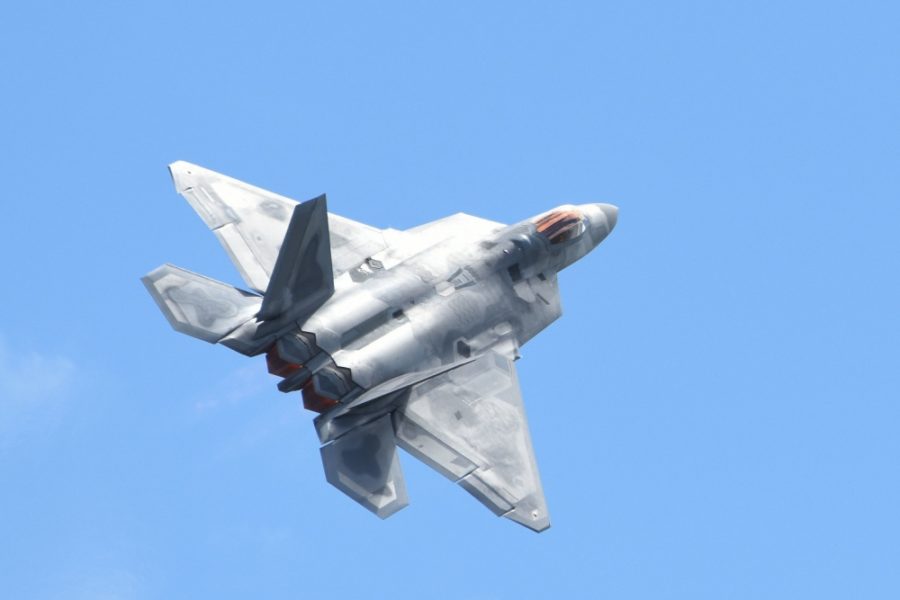The F-22 is a stealthy, penetrating, air dominance, and multirole fighter built for day, night, and adverse weather, full-spectrum operations.
The prototype YF-22 first flew as part of USAF’s Advanced Tactical Fighter competition on Sept. 29, 1990, followed by the flight of the first F-22 test aircraft in 1997. The Raptor flew its first operational sortie during Noble Eagle in 2006 and debuted in combat striking Islamic State ground targets during Inherent Resolve in 2014. The F-22 achieved its first air-to-air kill downing a Chinese surveillance balloon off the coast of North Carolina on Feb. 3, 2023.

Raptor is currently the world’s most advanced fighter and its mix of stealth, long-range supercruise, and multitarget engagement capability make it a key platform in USAF’s Indo/Asia-Pacific strategy. F-22’s advanced flight controls and high-performance thrust-vectoring engine enable extreme maneuverability. Features include six LCD color cockpit displays, APG77 AESA radar, EW system with RWR and missile launch detection, and advanced comm/navigation and data links.
USAF is aggressively testing enhancements to ensure the F-22’s “first-shot, first-kill” advantage against advanced threats until replaced by the Next Generation Air Dominance (NGAD) fighter in the 2030s. Combat-coded aircraft recently completed Increment 3.2B software upgrades adding high-resolution ground mapping SAR, threat geolocation, EA capability, and integrated SDB I, AIM-120D, and AIM-9X. The program employs an “agile” strategy to rapidly and continuously develop, test and field improvements, including adding technologies developed for NGAD back into the Raptor.
Ongoing efforts include IRST to stealthily track and target airborne threats, and stealthy external fuel tanks/pylons to extend unrefueled range. Other significant efforts include the Reliability, Availability, and Maintainability Program (RAMP), Link 16, and IFF enhancement. RAMP improves electrical power, replaces avionic fiber optics, adds more durable LO, and fixes structures and wiring. Link 16 will enable two-way networking with legacy aircraft via Multifunctional Information Distribution System/Joint Tactical Radio System (MIDS/JTRS). Initial installs began in FY22 and fleetwide upgrade is now planned for FY25.
USAF proposed retiring noncombat-coded Block 20 aircraft to fund NGAD development in FY23, retaining only modernized Block 30/35s. Congress blocked the move pending analysis of the costs to upgrade Block 20s to full combat capability. F-22 formal training is moving from Eglin, where it has been since Hurricane Michael ravaged Tyndall, to a new permanent location at Langley in 2023.
Contractors: Lockheed Martin; Boeing (production partner).
First Flight: Sept. 7, 1997.
Delivered: Oct. 23, 2002-May 2, 2012.
IOC: Dec. 15, 2005.
Production: 195.
Inventory: 185.
Operator: ACC, AFMC, AFRC (associate), PACAF, ANG.
Aircraft Location: Edwards AFB, Calif.; JB Elmendorf-Richardson, Alaska; JB Langley-Eustis, Va.; JB Pearl Harbor-Hickam, Hawaii; Nellis AFB, Nev
Active Variant: •F-22A. Fifth-generation air dominance fighter.
Dimensions: Span 44.5 ft, length 62 ft, height 16.6 ft.
Weight: Max T-O 83,500 lb.
Power Plant: Two Pratt & Whitney F119-PW-100 turbofans, each 35,000 lb thrust.
Performance: Speed Mach 2 with supercruise capability, ferry range 1,850+ miles with two external wing fuel tanks (farther with air refueling).
Ceiling: Above 50,000 ft.
Armament: One internal M61A2 20 mm gun (480 rds); two AIM-9 Sidewinders inside internal weapons bays; six AIM-120 AMRAAMs (air-to-air loadout) or two AIM-120s and two GBU-32 JDAMs or eight SDBs (air-toground loadout) in main internal weapons bay.
Accommodation: Pilot on ACES II zero/zero ejection seat.

